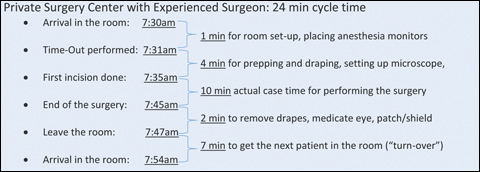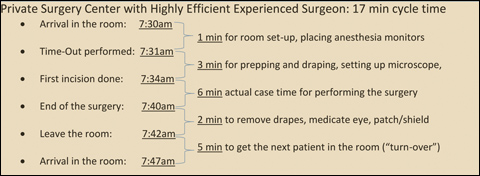Improving efficiency in the operating room
Surgeons need to document the timing of all steps in the operating room to become more efficient.
New ophthalmology residents sometimes mistakenly think that performing a surgery quickly is the key to doing more cases in a day. On the contrary, rushing a surgical procedure can result in a higher complication rate and less desirable outcomes, which will actually lower efficiency. Improving efficiency in the operating room is a multistep process that can result in the ability to help more patients per day while maintaining a high degree of safety and achieving excellent visual outcomes. This is particularly important for cataract surgery because the volume of cases is expected to increase to new highs.
Analyzing current times
The first step in becoming more efficient is to analyze your current level of performance. This means keeping track of key metrics during your operating days. We must document the timing of all steps in the operating room, not just the surgical time and the room turnover. The surgical time, or cut time, is from the first incision until the end of the surgery. The turnover is the time between wheeling one patient out of the operating room and bringing the next patient into the room.
We must also look at when the time-out was done. This is a crucial step in which everyone in the operating room confirms the patient, the correct eye, the surgery being performed, and the model and power of the intended lens implant. Remember, one of the most common causes of error is the implantation of the lens for patient A into patient B, often due to doing cases out of order and not performing a time-out. The time between arriving in the operating room and doing the time-out is typically when the room is being set up, equipment being primed, instruments being opened and the anesthesia monitors being placed.
The time for prepping and draping follows the time-out and the local anesthetic block if the surgeon is not doing topical anesthesia. This is also the time when the surgeon comes into the operating room, puts on the gown and gloves, and sits near the patient and brings over the microscope.
The surgical case time should not be rushed, but rather time taken to ensure efficiency of movement. Watching a highly skilled surgeon is like watching a ballet with every step having purpose with no wasted motion. Minimizing the number of times instruments come in and out of the eye increases efficiency but also induces less inflammation and ensures better incision integrity. A careless mistake during surgery as a result of rushing can result in a complication such as a ruptured posterior capsule, which can easily double the case time and result in a suboptimal visual outcome for the patient.

Images: Devgan U



When the surgery is over, the eye should be medicated and either shielded or patched, depending on the surgery and the surgeon’s preferences. This is also the time when the scrub tech is placing instruments back into the sterilizing trays. Finally, the patient is taken into the recovery area and the operating room is cleaned and disinfected in preparation for the next surgery, referred to as the room turnover.
Case example
While surgeons may complain of a slow room turnover, the actual cause of the inefficiency may actually be the set-up times before surgery and the time wasted after surgery. Figure 1 shows the 62-minute cycle time of a senior resident at a teaching hospital. The surgeon completes the cataract surgery in just 18 minutes, but he is frustrated that the cycle time to compete a case is more than 1 hour. When we analyze the timing, we can see that 22 minutes elapse from the time the patient is brought into the operating room until the first incision is made. This can be improved by pre-placing anesthesia monitors and setting up the microscope and phaco machines into predetermined positions in the room. After the surgery, the surgeon can complete his paperwork while the circulating nurse instills the eye drops and shields the eye. This results in a time savings of 20 minutes (Figure 2) while keeping the surgery time and turnover time the same. The new 42-minute cycle time means that 11 patients can be done in an 8-hour day instead of just seven patients.
We can yield further benefits by decreasing the room turnover as well as improving surgical technique. Using a phaco chop technique has been shown to be more efficient, both in terms of time and phaco energy placed in the eye, than the older divide-and-conquer technique. Similarly, having the scrub tech open and load the lens implant while the surgeon is performing nucleus removal will result in less wasted time during surgery. Most experienced surgeons should be able to achieve a cycle time of less than 30 minutes for a routine cataract, which means that two cases can be done per hour in one operating room (Figure 3). This yields 16 cases in the same 8-hour day.
Highly efficient surgeons can achieve cycle times of less than 20 minutes, which means three cases per hour in a single operating room, which nets 24 cases in the same 8-hour day (Figure 4). This type of surgeon should also consider using two operating rooms side-by-side and alternating between the rooms. This allows staff to set up and drape/prep the patient while the doctor is doing surgery in the other room. With this alternating room setup, surgeons can do six cataract surgeries per hour in a very controlled and manageable system. There are surgeons who are even more efficient and can do more cases per hour, but eventually it is diminishing returns. Surgeon fatigue can be an issue, and if I am the patient, I sure would not mind the surgeon spending an extra minute or two on my case to ensure the best possible outcome. The idea behind tracking your own operating room times is to be the best that you can be, not to compete with others. Again, it is not about speed; it is about delivering the best care in the most efficient way possible to benefit the most patients.
- For more information:
- Uday Devgan, MD, is in private practice at Devgan Eye Surgery, Chief of Ophthalmology at Olive View UCLA Medical Center and Clinical Professor of Ophthalmology at the Jules Stein Eye Institute, UCLA School of Medicine. He can be reached at 11600 Wilshire Blvd. #200, Los Angeles, CA 90025; email: devgan@gmail.com; website: www.DevganEye.com.
Disclosure: Devgan reports no relevant financial disclosures.









